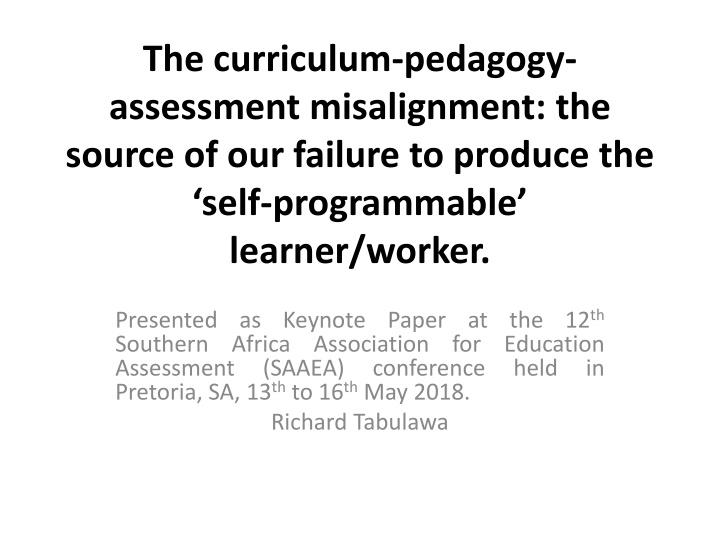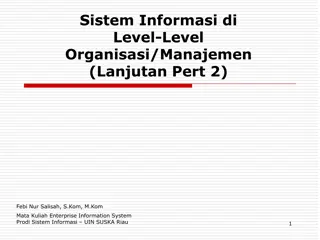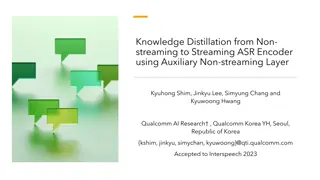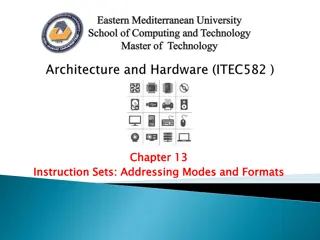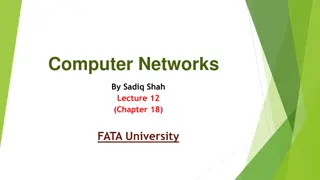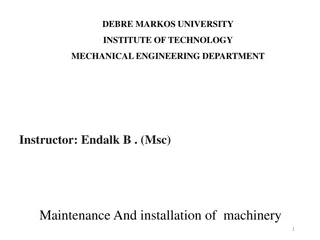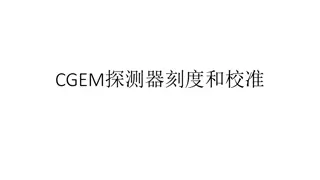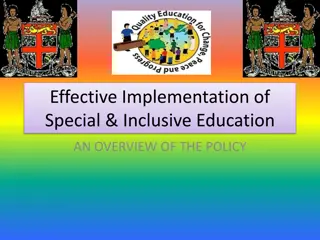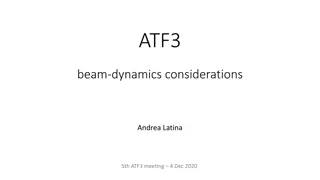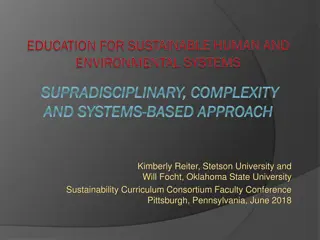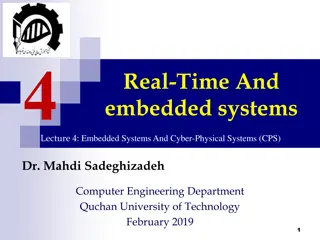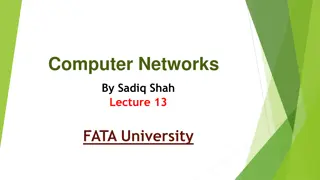Addressing Misalignment in Education Systems
Examining the impact of global-local dynamics on curriculum, pedagogy, and assessment alignment in education systems, with a focus on Botswana and the shift towards producing self-programmable learners/workers.
Download Presentation

Please find below an Image/Link to download the presentation.
The content on the website is provided AS IS for your information and personal use only. It may not be sold, licensed, or shared on other websites without obtaining consent from the author.If you encounter any issues during the download, it is possible that the publisher has removed the file from their server.
You are allowed to download the files provided on this website for personal or commercial use, subject to the condition that they are used lawfully. All files are the property of their respective owners.
The content on the website is provided AS IS for your information and personal use only. It may not be sold, licensed, or shared on other websites without obtaining consent from the author.
E N D
Presentation Transcript
The curriculum-pedagogy- assessment misalignment: the source of our failure to produce the self-programmable learner/worker. Presented as Keynote Paper at the 12th Southern Africa Association Assessment (SAAEA) Pretoria, SA, 13thto 16thMay 2018. Richard Tabulawa for Education held conference in
Introduction Theme: Local context in global context: encouraging diversity in assessment . Apt, given the intensification of the global-local dialectic i.e. globalization. Leading to both policy isomorphism (Rizvi, 2004)(policy sameness across contexts) and divergence (policy differences across contexts). isomorphic tendencies result from globally circulating traveling policies (Lindband and Popkewitz, 2004) such as assessment for learning . Divergence results from re-contextualization of the traveling policies through glocalization (Green, 1999) or hybridization (Popkewitz, 2000). Local contexts both originate and re-contextualize globally circulating discourses. The result: Nation states unique structural characteristics ensure that while educational changes in response to globalization share certain parameters [they] still vary greatly across regions, nations and localities (Carnoy and Rhoten, 2002, p. 6). Assessment, curriculum and pedagogy have not been spared by globalisation.
Objectives of presentation 1. To locate globally circulating reforms in curriculum, assessment and pedagogy (CAP)in their global contexts. 2. To discuss Botswana s response to CAP global reforms as a specific case of a general response to globalisation. 3. To argue that Botswana s CAP reforms aimed to produce a self-programmable learner/worker imbued with 21st century skills. 4. To argue for the centrality of the curriculum-assessment- pedagogy alignment if the learner above is to be produced. 5. To proffer possible impediments to education s positive response to the outcry for relevance .
The Global context A major global shift in the objectives and aims of education (i.e. philosophy of education) has taken place in the past 20 years, from an: Intrinsic value of education (e.g. UNESCO, UNICEF). Emphasis was on: Equity Rights Liberal democracy Knowledge for-its-own-sake To an: Instrumental Value of Education (e.g. World Bank, OECD).
Strategic input of new productive processes (Hopenhayn, 1993, p. 95). Knowledge has ceased (at least at the discursive level) to exist for its own sake. Market democracy This process of inversion constitutes a paradigm shift . Why? Education has been re-purposed (e.g. it is the key to national prosperity (Brown & Lauder, 1997); a tool of micro-economic reform (Dudley, 19998, p. 36). It is expected to produce a new kind of learner/worker Castell s programmable learner/worker . Definitions of relevant and quality education have changed to mean how well education serves the economy.
Further; Education reform now invariably means the tightening of the education-economy nexus. Has ideological undertones - the subsumption of the education sector by the economic sector. The shift is problematic : It s highly ideological it is taking place in a neoliberal context discourse of derision (Ball, 1990) blamed for the poor economic performance. It sets the stage for the commoditization of knowledge and its subsequent marketization of education. It de-professionalizes/technicizes the work of teachers through national curricula to break producer capture .
Assumptions Putting aside these concerns, let s assume that: the instrumentalisation of education/knowledge is inherently desirable. the tightening of the education-economy nexus is essential for economic prosperity, and that; nations have no choice but to reform their education systems to attune it to a new agenda. We would then need to address the following questions:
Questions What s behind this need for the instrumentalisation of education? What would constitute successful education reform ? What s required to successfully education/knowledge? How well are we doing in reforming education in the desired direction? To answer these questions requires: Knowledge of the expected product of the education process, and Conditions under which that product could be produced. instrumentalise
Whats the expected product? Castell s (1997) self-programmable learner/worker . What are his qualities/attributes? Self-directed Problem-solver Team worker Autonomous Creative/analytical Communicator Adaptable Life-long learner These are also called employability , generic and soft skills, which complement technical skills. Note that these skills are: High order Transferrable
Why this new product now? New patterns of production have emerged since the 1970s, variously termed post-Fordism (Brown & Lauder, 1992); fast-capitalism (Gee et.al. 1996); New economy (Windschitl (2002). Post-Fordism is 'based on adaptable machinery, adaptable workers, flatter hierarchies, and the breakdown of the division between mental and manual labour and learning (Brown & Lauder, 1992. p3). Driven by technological and organisational changes (Pitan, 2017). Technological change has led to uncertainty, unpredictability and constant change in the labour market. Knowledge & skills decay are pronounced. The changes have led to changes in the ethos, practices, values and discourses of the world of work (Johnson et al. 2003). New learner/worker is therefore technologically competent, team worker & problem-solver i.e. programmable worker. needed versatile, flexible, Self-
This workplace contrasts with the one of the Fordist era , characterised by: Centralized decision-making Conception-execution dichotomy Hierarchically organized entities Workers discouraged from being creative and innovative. Alienated and deskilled. Workers hired from the neck down (Gee et.al. 1996).
Listen to this! Tomorrow's workers will need to be able to engage in lifelong education, learn new things quickly, perform more non-routine tasks and more complex problem- solving, take more decisions, understand more about what they are working on, require less supervision, assume more responsibility, and - as vital tools to these ends - have better reading, quantitative, reasoning, and expository skills (World Bank, 1992, p.2). The 'new' economy places 'a premium on employees who can think creatively, adapt flexibly to the new work demands, identify as well as solve problems, and create complex products in collaboration with others (Windschitl (2002, 135).
Implications for education The skills demand of the labour market has changed. This has major implications for the nature of schools and schooling, as well as for society as a whole ( Gee et.al. 1996, 17). Nations should attune their education systems to the changed patterns of production. How should education look like? The education system has [...] to shift from a system that differentiates and socialises students for the rigid hierarchical division of labour of modem industrial societies, to a system producing high ability-high quality products with the ability to solve problems, think critically and apply new skills and techniques to different situations (de Clercq, 1997, p.156). Hence the global education reform fever to get education to serve more closely the labour market for human capital development. This is the intrumentalization of education/knowledge.
A local response to the shift Global stampede to reform education; Botswana not left behind. Revised National Policy on Education (RNPE) first attempt to respond to globalisation. RNPE a response to changed global patterns of production and industrial organization: Manufacturing techniques are changing and there is a general movement away from low skill, mass production assembly techniques towards automation and flexible specialization which require higher level of skills' (Republic of Botswana, 1993, 8). Diversifying away from (manufacturing) and the service sector. higher degrees of minerals to value-addition
'In the past decade rapid economic growth and the resulting changes in the structure of the economy have resulted in shortages skilled personnel. However, the education system was not structured to respond to the demand' (Republic of Botswana, 1994, 3). Claims: Botswana s economy is in some respect post-Fordist; The education system is failing the restructured economy; The supply-side (education) and the demand-side (economy) are not in sync. Evidence? Job Advertisements. This then justifies education reform to yield a new form of education, one that is inextricably linked to the needs of the economy: of
'The level and type of education that is offered is partly responsible for the speed with which industrialization can proceed' (Republic of Botswana 1993, 8). Education is extolled to 'offer individuals a life long opportunity to develop themselves and to make their country competitive internationally' (Republic of Botswana 1993, 4). Education is urged to provide a 'high level of technical and scientific skills (Republic of Botswana 1993, 8). Education is put at the centre of economic development hence the discourse of the demand side supply side.
What work force is required? [W]orkforce which can apply advanced technology and respond competitively to the changing demands of the international economy' (Republic of Botswana 1993, xii). Must possess these qualities and attributes: communication skills interpersonal skills work activity skills problem solving ability skills creativity innovativeness flexibility. Also called employability skills Recommended by the Botswana Confederation of Commerce, Industry and Manpower (BOCCIM), now Business Botswana. In short, the self-programmable learner/worker.
What does it take to produce the self- programmable learner (SPL)? Reforms currently underway reframe what is taught, how it is taught, how it learned, and how it is being evaluated in innovative ways that help (Price et.al. 2011, p.1) is personalize learning Closer attention to 3 elements: curriculum, assessment and pedagogy (CAP). SPL calls for an alignment between the CAP elements Biggs (1999) Constructive Alignment . teaching strategies and intended learning (McMahon & Thakore 2006) Defined as the coherence between assessment, outcomes in an educational programme. None of the 3 elements makes sense in isolation. A misalignment means failure of the system to produce the SPL, translating into the failure of the supply side to satisfy the demand side.
Figure 1: The Curriculum, Pedagogy, Assessment and Employability Relationship curriculum The self-programmable learner/worker (Employability Skills/21stcentury skills) Pedagogy Assessment
A curriculum is incoherent if it stresses employability skills but involves passive learning activities assessment approaches. Key employability skills must be embedded in the learning outcomes, teaching and assessment activities. Outcomes such as problem-solving, critical thinking, creativity etc. can t possibly be developed where learning and teaching are didactic and assessment is on factual information. The overall effect of constructive alignment is a focus on process- driven learning as opposed to content-based learning. This calls for new teaching/learning practices and assessment techniques. or largely summative
Quality control vs quality assurance Shift from emphasis on content (what to teach) to process (how to teach and assess) mirrors the quality control quality assurance debate. The shift in turn mirrors the changing patterns of production and industrial organization from Fordism to post-Fordism. Fordist mass production emphasizes Quality control: A quality controller evaluates a product at the end of the manufacturing process. If it conforms, it sent to consumers; if it doesn t it is discarded. QC is analogous to the examinations system (summative assessment); it is wasteful Assessment of learning. Quality assurance (QA)- a prominent feature of post-Fordist production. Continuous correction of product flaws Suits the service sector because of its continuous customer feedback. Analogous to Continuous assessment (CA) in education Assessment for learning the idea that classroom assessments should support ongoing teaching and learning (Price et.al. 2011). Assessment for learning is process-focused and therefore more likely to produce the self-programmable learner .
The RNPE and constructive alignment Was this alignment realised? Let s first understand the nature of curriculum, assessment and pedagogical reforms that took place: their nature What they emphasised What they envisaged.
Curriculum Skills-based curriculum i.e. the pre-vocational preparation strategy to address the academic/training divide through the integration of knowledge and skills. 'The development of the curriculum and instructional materials should reflect the world of work by promoting integration across subjects' (Republic of Botswana 1993, p.174). Integration (interdisciplinarity) and post-Fordist relations of production are connected Both are antithetical to hierarchy integration abhors subject hierarchies and the academic-vocational dichotomy. Post-Fordism abhors top-down controls in production as well as the conception- execution dichotomy, which characterise Fordist production. So both subject integration and post-Fordism are committed to democratic social relations. Content as medium for developing employability skills, no longer the main focus. Retreat of the academic tradition in favour of the utilitarian/instrumental tradition. Deductive process based on behaviourist model.
Teamwork as an illustration Teamwork an important aspect of post-Fordist relations of production. Demands cooperation between designers and craft workers i.e. the blurring of the divide between conception and execution, thinking and doing i.e. it favours teamwork. But teamwork decentralizes power controls within the production process and pluralizes control within the work context (Rassool, 1993). Collapsed subject boundaries (i.e. interdisciplinarity) permits subject specialists to come together to work on cross-curricular issues i.e. it fosters teamwork. Decentralised power favours democracy. There is, therefore, affinity between subject integration, post-Fordist relations of production and political democratisation. In short, the RNPE curriculum aimed to produce the self-programmable learner/worker.
Pedagogy Constructivist learner-centred pedagogy as official pedagogy. It resonates with post-Fordist production patterns and democracy. Meant to produce a certain kind of society and citizen/worker i.e. the self-programmable worker. Teachers to utilise innovative learner-centred approaches to teaching (Republic of Botswana,1999a:3). Such as project-work, fieldwork, group discussions, pair-work, class presentations, computer-guided learning, and many others (Republic of Botswana, 1999c: iii). To develop employability skills such as problem-solving, inquiry, critical thinking, communication skills, innovativeness, adaptability etc. Learner-centred education is considered the vehicle to drive societies and economies from mainly agricultural bases into modern and knowledge-based societies with the attendant economic benefits' (Chisholm and Leyendecker, 2008, p.202).
Assessment Introduction of assessment objectives i. Knowledge with understanding. ii. Skills development and application (Academic and technical skills) iii. Awareness, evaluation and decision making (Ways of thinking) iv. Research skills and data manipulation (Authentic assessment) (Project - 20%). v. Formative assessment introduced. It too, just like LCP, resonates with post-Fordist production patterns and democracy.
In summary There was an awareness to align curriculum, pedagogy & assessment. A skills-based curriculum to be delivered through a learner-centred pedagogy assessed both formatively and summatively. Skills and competencies related to the world of work to be tested were specified. Skills and competencies defined in terms of what the student is able to do . For the first time formative assessment (assessment for learning) was introduced meant to improve teaching and learning processes. What was the significance of the latter move?
Implications for classroom practice Given these curriculum. pedagogical and assessment reforms, one expected classroom climates characterized by: Dialogue Discussions Open-ended questions project-work, fieldwork, group discussions, pair-work, class presentations...' (Republic of Botswana 1999, iii). That is, classroom practice was to be process-oriented as well, not just product oriented Resulting in: Democracy and citizenship (tolerance) through (a) changed teacher-student relationship and (b) participation in class flattened hierarchies . New ways of knowing critical thinking, creativity, problem solving, innovation etc. (Griffin et.al., ) New ways of working collaboration (teamwork), communication, interpersonal skills (Griffin et.al.,). These 21stcentury skills are what characterize Castell s self-programmable worker required in a post-Fordist work environment.
But where are we now? Failed to produce the self-programmable learner/worker. Meaning failure to meet the demands of industry and society. The supply side and demand side mismatch. Declining quality of education (with test scores as proxies for quality). An education system in crisis.
But why the failure? 1. The pre-vocational strategy was minimalist and therefore could not lead to subject integration. Separate subjects with their distinctiveness were left intact (Fordist). The result: an inflexible, hierarchised curriculum the opposite of one needed for 21st century skills. While rhetorically the curriculum approach was constructivist in reality it was behaviourist. Highly specific and measurable behavioural objectives were used in syllabi construction. Under behaviourism (a) knowledge is atomised (b) skills are understood as narrow technical competencies (c) content is tightly specified and (d) outcomes are pre-specified/pre-determined as well as cast in measurable behavioural terms. (Tabulawa, 2009) This approach embeds a model of teaching and learning that is mechanistic, reductionist and that neglects the 'examination of inaccessible and unobservable mental events' (Tennant 1988, 107) such as critical thinking, creativity, independence i.e. soft skills. 2.
3. The behaviourist curriculum undercuts the constructivist learner-centred pedagogy. But behaviourism and constructivism engender incompatible practices in human beings. Constructivist learner-centred pedagogy stresses process, dialogue, cooperative learning, and the constructedness/situatedness of knowledge and behaviourism stresses, on the other hand, product, atomisation of knowledge and generally more teacher-centred practices. Leading to conceptual confusion resulting from a behaviourist curriculum that is to be taught in a constructivist manner and assessed in a constructivist manner . When this is dove-tailed to a tightly framed assessment regime in which tests and examinations precisely reflect the myriad of the specific objectives, it is not difficult to see how behaviourist outcomes contrast with learner-centred pedagogy. The result is the continued dominance of teacher-centred pedagogy, which cannot be expected to learner/worker. produce the self-programmable
4. High stakes testing resulting in a default philosophy of education (Gunzenhauser, 2003). Default philosophy of education tests designed to be part of a system of accountability drive the curriculum, limit instructional innovation and keep educators from establishing their own priorities and visions (p.52). Where it dominates, alternative visions/philosophies of education are difficult to articulate, implement or even imagine e.g. process-driven learning. High stakes examinations in our contexts lead to this default education is understood purely in terms examinations. These define quality in education . The result: setting of targets; preoccupation with position in the League Table; teaching to the test; inordinate pressure on principals(e.g. threats to retire them) All these negate CAP alignment, and by extension, the possibility of a self- programmable learner/worker. of performance in standardized
Conclusion Presentation pedagogical and assessment reforms in their global context. That the self-programmable learner that they seek to produce may only be possible if there is constructive alignment between the assessment. That for a number of reasons, the alignment has proved illusive; one of the reasons being the backwash effects of assessment. Ironically, assessment holds the key to the alignment of the three elements, and therefore to the production of the self-programmable learner/worker. attempted to nest local curriculum, curriculum, pedagogy and
